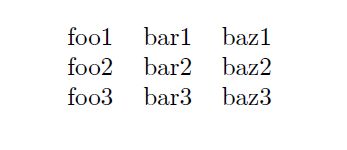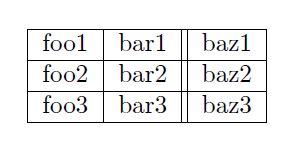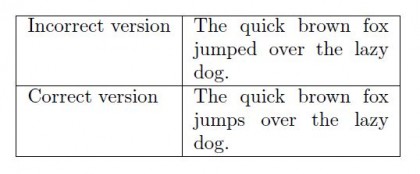I sort of neglected my Let’s Learn LaTex series for a while now. The last LaTex related post I made was in April and now it is already November. I figured I might as well get back to it, and hopefully if you were following along you can refresh yourselves using the link above.
Last time I promised to explain tables, but then I realized that tables are quite a big topic so I will split this lesson into two parts. Today I will talk about basic table structure, and next time I’ll outline some more advanced table tricks.
How do you make a table in LaTex? How do you make a list? If you recall from the last post, lists were LaTex environments. So are tables. Instead of using enumerate or itemize environment, you use tabular instead. The \begin{tabular} and \end{tabular} keywords set it up up just like lists. Let me show you a simple one:
\begin{tabular}{ l c r }
foo1 & bar1 & baz1 \\
foo2 & bar2 & baz2 \\
foo3 & bar3 & baz3 \\
\end{tabular}
It will make this fine looking table:
It is spartan and simplistic but we can fix that in a few seconds. Let’s talk about the basics. The tabular environment takes an argument which is a textual string that “describes” the columns, and it accepts following literals:
- l – Left aligned column
- c – Centered column
- r – Right aligned column
- | – A vertical line / column divider
It does not really matter which character you use in the example above, because all the columns are of equal width and LaTex will do auto-kerning and alignment on them as usual.
Once you define the columns, you just start typing your data in, and place the & character when you want to skip to the next column and you end the row with the \\. Naturally if you want to use the & symbol in your table you will need to escape it as \&
Now let’s add some lines. You can use the | (pipe character) to add vertical lines in the column definition string and \hline command to add vertical lines in the body of the table like this:
\begin{tabular}{| l | c || r |}
\hline
foo1 & bar1 & baz1 \\
\hline
foo2 & bar2 & baz2 \\
\hline
foo3 & bar3 & baz3 \\
\hline
\end{tabular}
The result will look like this:
Much nicer, eh? You should note that LaTex does not have the equivalent of the <th> html tag that would automatically style a row as a column header. You have to do this sort of thing manually either by using multiple \hline commands or by using \textbf or other formatting on individual table cells.
Similarly to HTML tables, the tabular environment won’t wrap long text lines around. This behavior is by design, but it often catches new LaTex users by surprise when their table slides right off the page. Let’s test it and create a nice table with some long sentences. To make it more fun lets use everyone’s favorite panagram featuring that pesky brown fox:
\begin{tabular}{| l | l |}
\hline
Incorrect version & The quick brown fox jumped over the lazy dog. \\
\hline
Correct version & The quick brown fox jumps over the lazy dog. \\
\hline
\end{tabular}
Yes, despite the popular belief the brown fox jumps over the dog all the time – like right now for example. If he had jumped over him once at some point in the past and never did it again he would ruin the panagram by ommiting the letter ‘s’. But I digress. For our purpose let’s say we have a rather narrow page. In such case the table above could easily end up looking like this:
Fortunately this is easily fixable by using p{w}, m{w} or b{w} instead of l, c and r where w is some width attribute:
- p{w} – top aligned wrapped paragraph column
- m{w} – middle aligned wrapped paragraph column
- b{w} – bottom aligned wrapped paragraph column
The value of w must be a number followed by measurement unit such as in (inches), cm (cemtimeters) or em (internal LaTex measure which defaults to the width of letter ‘m’ in the current font). Let’s try this with our example:
\begin{tabular}{| l | p{10em} |}
\hline
Incorrect version & The quick brown fox jumped over the lazy dog. \\
\hline
Correct version & The quick brown fox jumps over the lazy dog. \\
\hline
\end{tabular}
Here I set the width of the second column to be approximately ten widths of the letter m, which resulted in this output:
As you can see, the result is much better.
One of the lovely things about LaTex is that it was written by programmers for programmers. Programmers are lazy beasts, so anything that requires lots of typing or copying and pasting will usually get lumped into some sort of a function. This is true for tables. For example, if you need to define several identical columns, you can use the * (star/asterisk) notation in your column definition. It usually takes the form of:
*{howmany}{columndef}
The value of howmany is a number and the value of columndef is actual column definition (for example c or a p which can be accompanied by some pipe characters to create column border). Let me give you a quick example:
\begin{tabular}{ l | *{4}{c|} }
Student Name & HW 1 & HW 2 & HW 3 & HW 4 \\
\hline
John Smith & A & B & A & F \\
Jane Smith & C & C & F & F \\
Bob Johnson & A & F & A & B \\
\end{tabular}
It will look like this:
The last thing I want to show you today is spanning. Sometimes you want to have rows that span more than one column. In HTML tables you can achieve that by sticking an attribute on a <td> tag. Since LaTex uses a much simpler table structure, and the column definition attribute is already overloaded as it is, things get hairier here – but only a little bit.
Essentially instead of typing the columns or rows that need to span, you use a special command such as:
\multicolumn{howmany}{columndef}{content}
Let me give you a quick example:
\begin{tabular}{| l | *{4}{c|} }
\hline
\multicolumn{5}{|c|}{Homework Grades} \\
\hline
Student Name & HW 1 & HW 2 & HW 3 & HW 4 \\
\hline
John Smith & A & B & A & F \\
Jane Smith & C & C & F & F \\
Bob Johnson & A & F & A & B \\
\hline
\end{tabular}
I’m sure you can see the \multicolumn statement replaces an entire row here, but if it didn’t you could still use & characters to the left and right of it. Here is the output:
If you want spanning rows, you will need to use a package called multirow which is something I did not explain yet. Which is why I think the next lesson will be about importing packages and then I will swing back to tables.
| Let’s Learn LaTex | |
|---|---|
| << Prev | Next >> |





